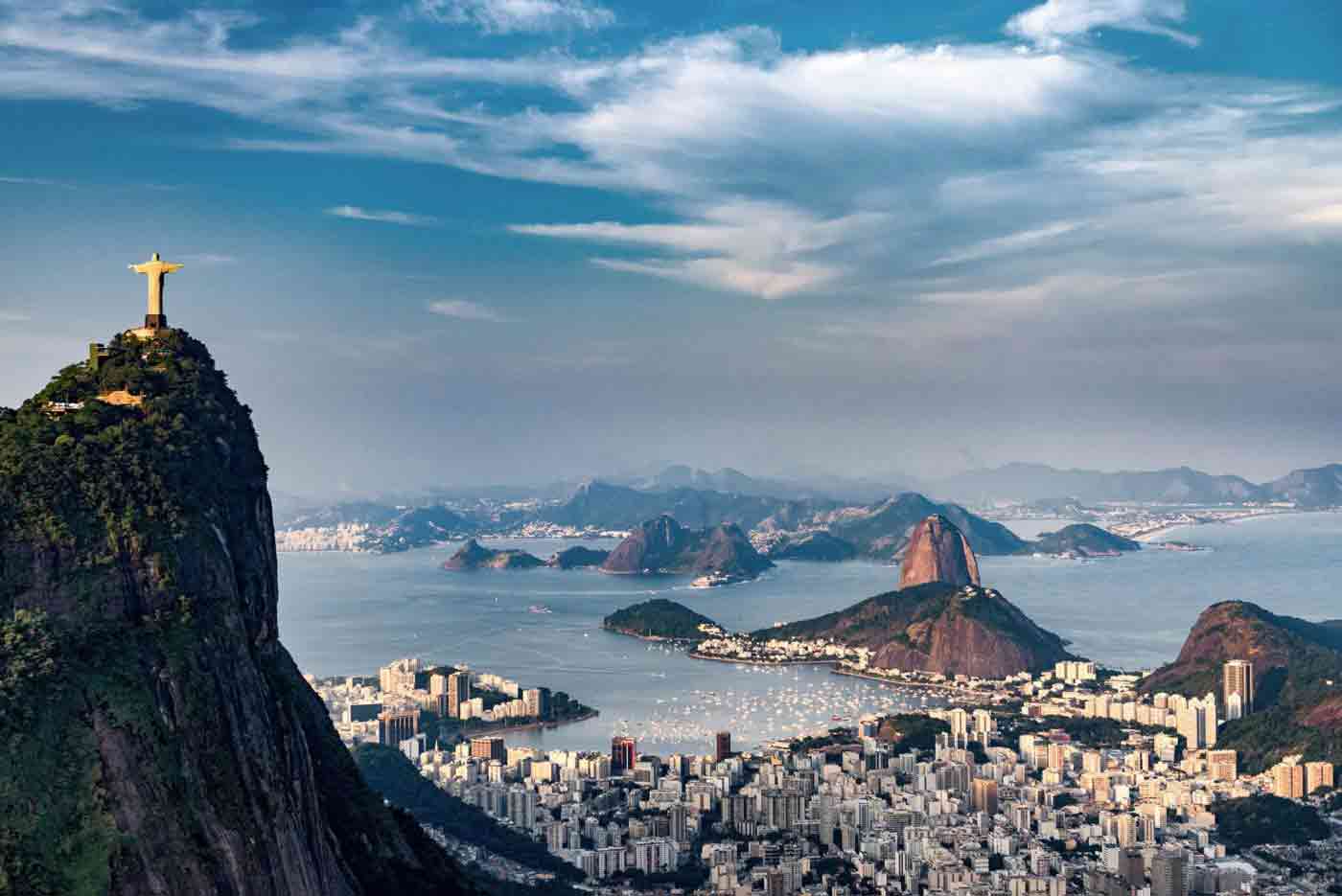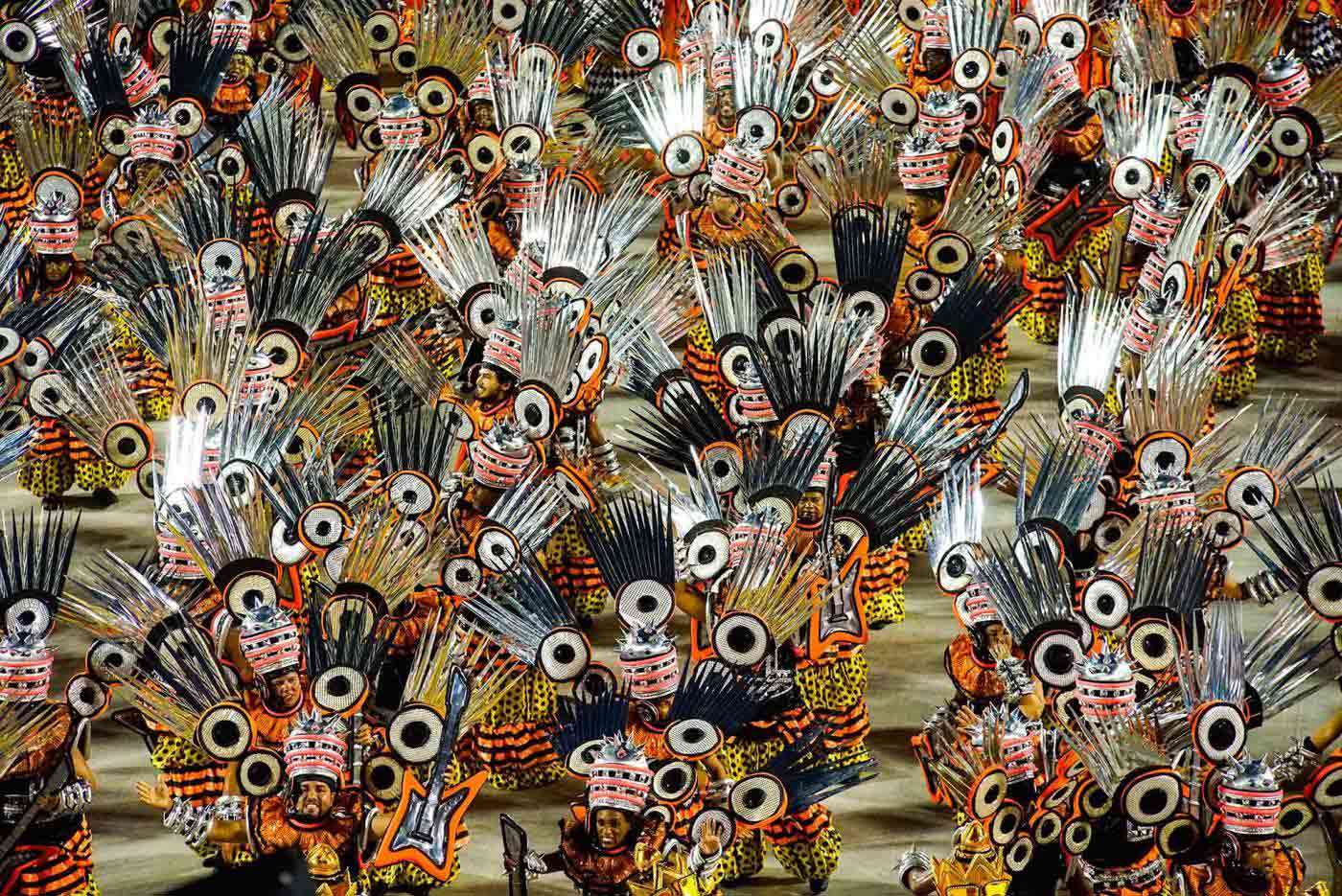Samba de Janeiro
Crawling in traffic and crowds through the streets of Rio in the early hours, I watch as thousands of people – young and old, in limos and on foot, locals and tourists, participants and audiences – head to the main event at the Sambódromo da Marquês de Sapucaí, a half-mile-long parade ground flanked by stands and private boxes, much like a stadium. From the car, I feel the energy pulsing through the glass and a real sense of community, people from all walks of life coming together to celebrate.
Inside, the atmosphere is electric, tumultuous, from the throng of 75,000 revellers and participants. We’re in our camarote, an epic private box, a sort of nightclub meets festival meets viewing platform where ‘private’ means you share with a thousand other revellers. It’s one of many such options of different price points, offerings and demographics. Ours (called Nosso) has been arranged by Belmond and, although it’s not the most acclaimed, it’s allegedly the most tourist-friendly and luxurious, with the average punter expected to shell out thousands of dollars per night for a pass. If you think the price point might be a challenge for some folk, that isn’t the case – Cariocas will save for months to bag themselves a golden ticket to a camarote like this, which provides unlimited food, drink, entertainment and a perfect view of the parade.
Over the next couple of days here at the Sambadrome, around 200 samba schools will compete to become the coveted Carnival champions. Flamboyant dancers dressed in elaborate and spellbinding, often hand-made costumes (the envy of drag queens the world over) dance diligently choreographed steps in unison. Others samba furiously onboard over-the-top, creative floats; and each of the thousands of members of every participating school sings their heart out passionately to their chosen school song, like it’s the last night on earth. It’s unlike anything I’ve ever seen. I stand slack jawed for hours as they pass in front of me, school by school – each worthy of the coveted prize.
To witness this spectacle is magical enough, but to participate takes the experience to a whole other level. With some Belmond-concierge magic, I’ve been invited to march with the friends and family of the incumbent winners Beija Flor (which means ‘hummingbird’ or ‘kiss the flower’). And so, donning the samba school’s supporters’ jersey emblazoned with their slogan ‘Today, Tomorrow, For Ever’, I too dance the enchanted half-mile – with a passion equal to the locals, I’m told, but with the coordination of a foreigner.
United we dance
Down on the Sambadrome floor, I get talking to some participants, observing that many of the performances that went before us had a focus on diversity as a theme – some going even further, with seas of rainbow flags and political placards urging unity and peace.
I’m told that this year’s Carnival is under the country’s (and city’s) right-wing, ultra-conservative government. So, in protest, many of the schools have taken a stance to use their time at the Sambadrome (and consequently on national and international TV) to speak out against a growing tide of racism, religious intolerance and homophobia.
On a more local level, the schools are at the very heart of the communities they represent, many participants being from the favelas, who aren’t supportive of President Bolsonaro’s imperialist and elitist views. The Bolsonaro dynasty – two generations of the same political family – dominate Rio’s politics and it’s said that some violent atrocities have been committed against their opponents since their rise to power, with many accusing them of ruling with fear, as well as imposing unscrupulous policies, among them the destruction of the Amazon rainforest and ignoring the rights of indigenous communities.
The rawest of incidents for the tens of thousands of Sapucaí participants walking the strip was the brutal assassination of council-woman Marielle Franco, a well-loved politician who stood up for the rights of the residents of Rio’s favelas. She was of African descent, an out lesbian born in the shanties of Rio and an outspoken opponent and enemy of the aristocratic Bolsonaros. Today marks close on the first anniversary of her murder and the perpetrator and chief suspect remains unfound, but has allegedly been personally linked to Rio’s Senator Flávio Bolsonaro, the President’s son, who dismisses the killing as an accident, a case of being in the wrong place at the wrong time.
It’s heartwarming to see how a community can come together through this medium of celebration, to send a message to the world that humans won’t tolerate unjustness. And to march as part of this community is a real honour, resonating with my own beliefs and, much like when I take part in my own community’s Pride celebrations, it’s made being here and walking the strip all the more special, powerful even.
But nothing is as powerful as the news that comes just as I board the plane home. Beija Flor was unable to hold on to its title this year. Instead, the torch passed to a different school, Mangueira. Its entry tells the story of the Amazon natives, positions Brazilians of African descent as national treasures and warns of the dangers of imperialist ideals and colonisation. And on its final float sat the ‘grand marshal’ of its parade – Marielle Franco’s widow, Monica.
To understand Rio is to understand its complex society – the gap between rich and poor, European and indigenous/African, block parties and balls, real samba and my poor attempts to do it. And even with such divides, this age-old tradition, this celebration can be a social leveller that helps everyone understand what it truly means to be human.
It’s often said that Rio is the sexiest city on earth and I wholeheartedly agree. But I wonder why that is. Perhaps it comes naturally to want to be at one with your surroundings when you grow up somewhere so heavenly. And heavenly Rio is. But alongside the beauty, there’s grit – a quality that underpins all my favourite world cities. Yet, despite the obvious and well-documented danger on its streets, it would be a tragedy to gentrify Rio and turn it into yet another Western-world urbanity.
I came here expecting to experience a spectacle that would blow my mind, but I didn’t think that my time in the city would be transformative.
Saudade, Rio. It’s no wonder they call you the ‘Cidade Maravilhosa’. You really are absolutely wonderful.
Photography by Riotour, Microgen, courtesy of Belmond and courtesy of Carlos Tufvesson
Get out there
Do…
… bag a window seat on your flight in. The bird’s-eye view on the approach into Rio is simply breathtaking.
… participate in the local blocos and bandas. They’re generally safe, with an up-for-it international crowd, but keep your wits about you. You may need to adhere to a dress code (usually themed by colour) or wear very little.
… consider investing in a camarote for the Sapucaí – it’s a great, fun-filled way to enjoy the parade.
Don’t…
… miss some of the gay nightlife in Rio, although much of the scene is integrated. There’s even a gay ball during Carnival.
… take much with you if you’re heading to the beach or streets during this time. And try to keep your phone in your pocket as much as possible.
… leave without taking the time to sightsee Rio – it’s a breathtaking city. Check out Sugarloaf Mountain, Christ the Redeemer and Parque Lage.
At OutThere, we believe in boundless travel. But we understand that some destinations can pose challenges to travellers that complicate visiting them. We advise all visitors to inform themselves about local legislation and customs, and to work with a trusted travel provider in order to ensure a safe and pleasant holiday.









